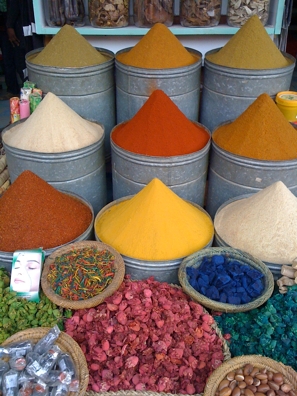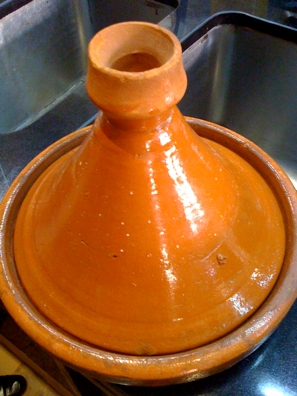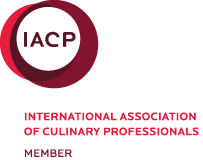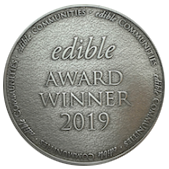During our four days in Marrakech, I was most excited by the prospect of taking a cooking class. A very international group of 9 of us did a hands-on cooking workshop at La Maison Arabe, a lovely hotel in the Medina that had a terrific kitchen setup for classes. We started off with a short lecture by our English-speaking guide, who talked us through the essentials of Moroccan cooking.
Much of Moroccan cuisine centers around the tagine—the terra-cotta cooking vessel with the cone-shaped lid—historically used over a charcoal fire but more commonly on a gas burner with a metal diffuser (the word refers both to the pot and the dish cooked in it). Moroccans eat tagine pretty much every day: chicken with salty preserved lemon and olives; lamb with prunes or apricots. Couscous is another staple, either a sweet-ish version topped with caramelized onions and raisins, or with an array of vegetables: carrot, turnip, cabbage, zucchini, eggplant, pumpkin and chickpeas.
I was surprised by the range of vegetables that figure in Moroccan cooking. Every meal we had began with a huge platter of prepared vegetables: carrots scented with cumin; eggplant sautéed until soft with tomato; pickled cabbage; beets with red onion; roasted peppers; zucchini; sweet-savory tomato confit.
I was also surprised by the prevalence of cumin, which I normally associate with Mexican food. (We heard repeatedly, both in the class and at stops at a couple of spice shops, that cumin is good for digestion.) Moroccan cooking centers on five spices: salt, white pepper, turmeric, ginger and saffron. Many dishes also include a 35-spice blend called ras el hanout and cinnamon. The flavors are deep, complex, spicy, but not hot.
I managed to bring home four good-sized containers of saffron, a steal at $10 each (compared to $120 for a tin at our local Mediterranean market). I bought packets of cumin, Moroccan curry, a four-spice blend and, of course, ras el hanout. And I bought a jar of preserved lemons in the souk, which made it home intact in my suitcase.
Not surprisingly, our cooking class involved a chicken tagine with preserved lemon and olives. We started with a marinade: the lemon pulp, some garlic, red onion, parsley, saffron, pepper, ginger, turmeric and saffron, butter and olive oil. It all went into the tagine, and then simmered over medium heat for about 40 minutes until the chicken was done and the sauce thickened. We garnished the tagine with slivers of preserved lemon rind and Moroccan olives.
I’m planning to experiment heavily with Moroccan cooking in the next couple of weeks, so stay tuned for more recipes and techniques.









Love this Bryn. I am a big fan of cumin and can’t wait to see some of your new recipes here!
Pingback: Making and using preserved lemon. | writes4food | cooking, eating, drinking in the Midwest
Pingback: Moroccan chicken tagine. | writes4food | cooking, eating, drinking in the Midwest
Pingback: Great marinade for summer grilling. | writes4food | cooking, eating, drinking in the Midwest
Pingback: Couscous with roasted vegetables. | writes4food | cooking, eating, drinking in the Midwest
Pingback: Millet-vegetable fritters. | writes4food | cooking, eating, drinking in the Midwest
Pingback: Roasted carrot and red pepper salad. | writes4food | recipes and wisdom from a Midwestern kitchen
Pingback: Moroccan-inspired roasted carrot-bell pepper soup. | writes4food